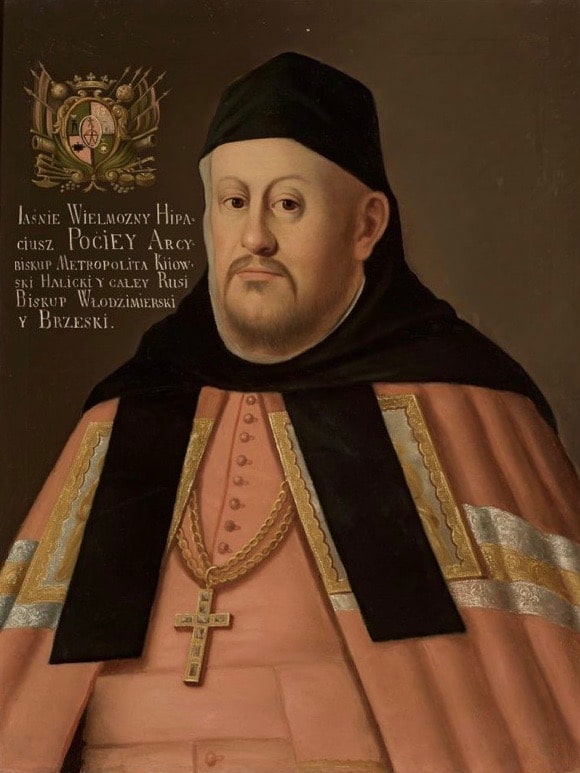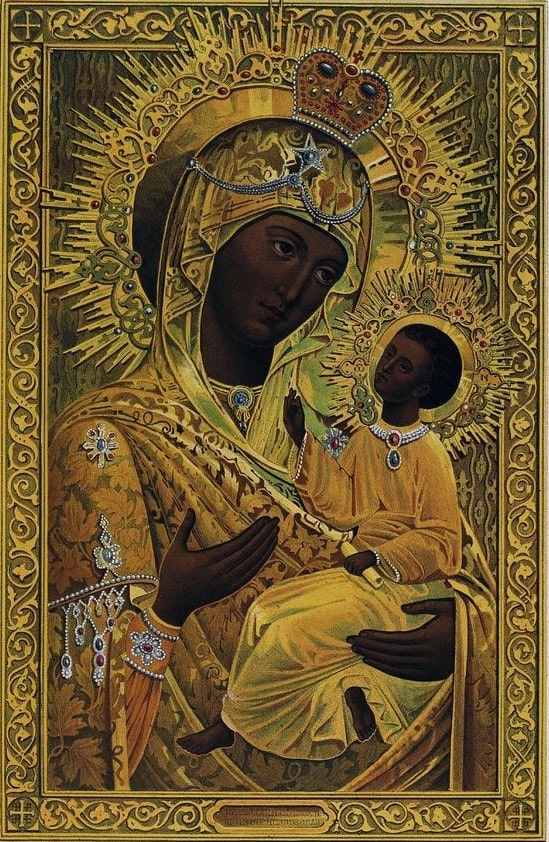Hypatius Pociej (secular name Adam), of the coat of arms Vaha, was born on 12 August 1541 in the village of Różanka, Podlachia area, and died 18 July 1613 in the city of Volodymyr. He was a Ukrainian-Belarusian state and church figure, bishop and metropolitan, and writer [1]. In his childhood and youth he spent time at the court of Mikołaj Radziwiłł The Black, where he studied at a Calvinist school, and also at the court of King Sigismund Augustus. He probably studied at a German university and became a Calvinist. From 1566 he was a provincial clerk, from 1576/1577 a provincial judge, and from 1588 a castellan in Brest, senator of the Commonwealth. Returning to Orthodoxy in 1573 or 1574, he took part in the first union meetings (1588) and in 1590–1592 at sessions of Orthodox councils. On 31 March 1593, he received monastic tonsure, and on 27 May of that year he was ordained as bishop of Volodymyr and Brest. In 1594, he joined the union party and signed a number of documents that detailed the union program for the Ruthenian hierarchy, in particular “33 articles” of the Union of Brest (↑). From the end of 1595 to the start of 1596, he and Cyril Terlecki were delegated to Rome, where the Union of the Kyivan Metropolitanate was agreed upon and then announced at a council in Brest in October 1596. He was an active participant of the Union Council of Brest. As one of the leaders and idealogues of the Union, he actively implemented it, and also with violent methods.1Jan Dzięgielewski, “Pociej (Potij) Adam, póżniej Hipacy, h. Waga (1541–1613)”, in: Polski Słownik Biograficzny, t. 27: Pniowski Jan–Potocki Ignacy, cz. 1, red. Emanuel Rostworowski, Wrocław–Warszawa–Kraków: Polska Akademia Nauk, 1982, s. 28–34.
In the period after the Union, Pociej’s views changed: he began to defend latinizing changes in the Church’s Eastern rite. On 2 October 1599, he became metropolitan of Kyiv, which was confirmed by the Pope of Rome on 15 November 1600.
Pociej is considered to be the author of several polemical works, like “The Union” (1595), “Antirrhesis” (1599 and 1600), “A Defense of the Council of Florence” (1603), “An Embassy to Pope of Rome Sixtus IV (1605), “About Privileges” (1605?), “Harmony” and “Heresy” (1608), and poetry highly evaluated by literary scholars.2Руслан Ткачук, Творчість митрополита Іпатія Потія та полемічна література на межі XVI – початку XVII ст. Джерела. Риторика. Діалог, Київ: Видавничий дім Дмитра Бураго, 2011, с. 42–112.
In 1597, the press of the Mamoniczów published Pociej’s polemical work “Справедливое описанье поступку, и справы сынодовое, и оборона згоды и единости съвершенное. Котораясе стала на сыноде берестейскомъ. В року, 1596, напротив явного фальшу и потвары синоду якогось змышленного а радшей съборища покутного геретыческого в дому прыкатъномъ геретыческом отправованого Через одного зъ преложоныхъ духовныхъ церкви руское”.3Леонід Тимошенко, Руська релігійна культура Вільна. Контекст доби. Осередки. Література та книжність (XVІ – перша третина XVII ст.), Дрогобич: Коло, 2020, с. 579–604. The publication is fairly unique, for a single copy is preserved in the fund of the Library of the Russian Academy of Sciences (St. Petersburg). The work is characterized above all by its factual content: it presents previously unknown details of the proceedings of the Brest Councils in 1596. A gem of the work is the description of a “miracle” which happened during the proclamation of the Union, when “wine transformed into water”. (In fact, there was a mistake during the time of the eucharist that was quickly corrected.) The finding of this polemical work significantly strengthens the paradigm of a literary process known as the Brest cycle. The conception of the history of the event and about polemics has now been significantly enriched. It is noticeable that Pociej’s next works were printed in Vilnius. Some other authors were also published here. Together with Ostroh, Vilnius became a center of polemics. With the decline of publishing in Ostroh, Vilnius became the exclusive center of polemics (↑).
Up to 1599, with the nomination of Pociej to the Kyivan Uniate Metropolitanate, his connections with Vilnius were sporadic. After that, he immediately gave an order to the archpriest of Vilnius and, using the support of Sigismund III Vasa, ordered him to lock Holy Trinity Church until “heretic” Stefan Zizanij left. Beginning in the second half of 1600, the sources attest that the metropolitan stayed in Vilnius, where his residence was at Dormition Cathedral. In a letter from Vilnius to the voivode of Trakai, Mikołaj Krzysztof Radziwiłł The Orphan, on 1 June 1601, Pociej wrote that here he “guards the walls”.4Ibid., с. 332.
The greatest intensification of the Orthodox-Uniate conflict in Vilnius was in 1608–1609 (↑), when not only brothers of Holy Spirit Monastery protested against Pociej but all the city’s Orthodox clergy. Pociej managed to resolve the conflict, as a consequence of which all the churches in Vilnius, with the exception of Holy Spirit Monastery, transferred to the Union. The take-over of Holy Trinity Monastery happened in the presence of the royal infantry, and imprisoned Orthodox priests were held in the bell tower. On 11 August 1609 there was an attempt on Pociej’s life: in a market in front of city hall some servant attacked him and wounded his arm. On 25 July 1609 the metropolitan called an archieparchial council in Vilnius. Finally, in Vilnius the matter of the Union triumphed.5Tomasz Kempa, Konflikty wyznaniowe w Wilnie od początku reformacji do końca XVII wieku, Toruń: Wydawnictwo Naukowe Uniwersytetu Mikołaja Kopernika, 2016, s. 261–294.
The seminary founded by Metropolitan Pociej in 1601 played an essential role in the formation of Holy Trinity as a Uniate center, as did the creation in 1609 of a Uniate brotherhood (↑). Pociej’s designation of Josyf Veliamyn Rutsky (↑) as his co-adjutor for the metropolitan see (16 October 1611) was an important step. Rutsky took his hierarchical oath in Vilnius in Pociej’s presence.6 Леонід Тимошенко, Руська релігійна культура Вільна, с. 335, 343.
At the start of the 17th century, Holy Trinity Women’s Monastery was still functioning at Holy Trinity Monastery. The first superior was Barbara Sapieżanka, who figures in the sources in 1609. A book depository functioned at Holy Trinity Monastery. It is known that Pociej in his testament of 27 April 1613 willed his Latin books to Holy Trinity Monastery.7Ibid., с. 349–350.
An event with resonance not only for Vilnius but for the whole Uniate Church (and the Orthodox world in Eastern Europe) was the arrival from Muscovy of disgraced Metropolitan Ignatius of Moscow. In the first half of 1612, he settled in Holy Trinity Monastery. Pociej made efforts so that the patriarch would convert to the Union.8Ibid., с. 350–352.
In 1609, Pociej ordered that the ancient icon of the Mother of God Hodigitria be brought from Dormition Cathedral, for which a separate altar of the Mother of God, with a curtain, was prepared, according to a “Latin” model [2] (↑).
Also in 1609, after Pociej was attacked and wounded, that incident was noted on a silver tablet which was placed on a wonder-working icon of the Most Holy Lady Mary. The author of the Uniate work “Jedność Święta Cerkwie wschodniey y Zachodniey” (Union of the Holy Church of the East with the West) fully quoted the text in his work: “The year of God 1609, the 11th day of August. Sent by schismatics from new churches in Vilnius, one rogue, a criminal who wanted to kill Father Hypatius (Pociej), metropolitan of Kyiv, violently cut with a sword his cassock and shirt, but didn’t hurt his neck. With this blow, he cut off two fingers from the left hand with a ring. But the Lord God, on behalf of the Most Holy Lady, miraculously preserved him from sudden death. He then left this tablet with the detached ring here as a memorial on the image of the Most Holy Lady for veneration.”9Ibid., с. 352.
The tradition and practice of burial within the walls of Holy Trinity Monastery and Church was continued at the end of the 16th into the 17th centuries. In the work “Holy Unity” (1632), the death of the first Uniate metropolitan, Michał Ragoza, is recalled. He was buried in the monastery: “His revered body reposes in Vilnius at Holy Trinity Church in a special chapel, decoratively prepared and funded by The Most Honorable Yy. M. Mr. Janusz Skumin-Tyszkiewicz, voivode of Trakai. And so, for this burial a separate chapel was built, about which nothing is known from other sources. It is credible that the burial happened with the consent of the metropolitan(↑) (↑).10Ibid., с. 353.
Pociej was buried in the Dormition Cathedral in Volodymyr, center of the Eparchy of Volodymyr-Brest, of which he was administrator to the end of his life.
Leonid Tymoshenko
Išnašos:
| 1. | ↑ | Jan Dzięgielewski, “Pociej (Potij) Adam, póżniej Hipacy, h. Waga (1541–1613)”, in: Polski Słownik Biograficzny, t. 27: Pniowski Jan–Potocki Ignacy, cz. 1, red. Emanuel Rostworowski, Wrocław–Warszawa–Kraków: Polska Akademia Nauk, 1982, s. 28–34. |
|---|---|---|
| 2. | ↑ | Руслан Ткачук, Творчість митрополита Іпатія Потія та полемічна література на межі XVI – початку XVII ст. Джерела. Риторика. Діалог, Київ: Видавничий дім Дмитра Бураго, 2011, с. 42–112. |
| 3. | ↑ | Леонід Тимошенко, Руська релігійна культура Вільна. Контекст доби. Осередки. Література та книжність (XVІ – перша третина XVII ст.), Дрогобич: Коло, 2020, с. 579–604. |
| 4. | ↑ | Ibid., с. 332. |
| 5. | ↑ | Tomasz Kempa, Konflikty wyznaniowe w Wilnie od początku reformacji do końca XVII wieku, Toruń: Wydawnictwo Naukowe Uniwersytetu Mikołaja Kopernika, 2016, s. 261–294. |
| 6. | ↑ | Леонід Тимошенко, Руська релігійна культура Вільна, с. 335, 343. |
| 7. | ↑ | Ibid., с. 349–350. |
| 8. | ↑ | Ibid., с. 350–352. |
| 9. | ↑ | Ibid., с. 352. |
| 10. | ↑ | Ibid., с. 353. |
Sources of illustrations:
| 1. | Held in: MNW, 130192 MNW (Available at: Cyfrowe zbiory Muzeum Narodowego w Warszawie, https://cyfrowe.mnw.art.pl/pl/katalog/500792, accessed: 2021 12 01). |
| 2. | Held in: MNW, 145073/170 MNW (Available at: Cyfrowe zbiory Muzeum Narodowego w Warszawie, https://cyfrowe.mnw.art.pl/pl/katalog/709783, accessed: 2021 12 01). |




